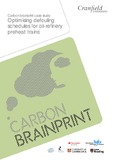JavaScript is disabled for your browser. Some features of this site may not work without it.
| dc.contributor.author | Parsons, David J. | - |
| dc.contributor.author | Chatterton, Julia C. | - |
| dc.contributor.author | Wilson, Ian | - |
| dc.contributor.author | Ishiyama, Edward | - |
| dc.date.accessioned | 2012-02-16T23:02:04Z | |
| dc.date.available | 2012-02-16T23:02:04Z | |
| dc.date.issued | 2011-07-31T00:00:00Z | - |
| dc.identifier.uri | http://dspace.lib.cranfield.ac.uk/handle/1826/7000 | |
| dc.description.abstract | In an oil refinery, crude oil is heated to 360-370°C before entering a distillation columnoperating at atmospheric pressure where the gas fraction and several liquid fractions withdifferent boiling points (e.g. gasoline, kerosene, diesel, gas oil, heavy gas oil) are separated off.The crude oil is heated in two stages. The preheat train - a series of heat exchangers - heats itfrom ambient temperature to about 270°C when it enters the furnace, known as the coil inlettemperature. The furnace then heats the oil to the temperature required for distillation.The purpose of the preheat train is to recover heat from the liquid products extracted in thedistillation column. Without this, 2-3% of the crude oil throughput would be used for heating thefurnace; with the preheat train up to 70% of the required heat is recovered. It also serves tocool the refined products: further cooling normally uses air or water. Over time, fouling reduces the performance of the heat exchangers, increasing the amount ofenergy that has to be supplied. It is possible to bypass units to allow them to be cleaned, withan associated cost and temporary loss of performance. The cleaning schedule thus has animpact on the overall efficiency, cost of operation and emissions. The group at the Department of Chemical Engineering and Biotechnology at Cambridgedeveloped a scheduling algorithm for this non-linear optimisation problem. It yields a good,though not-necessarily optimal, schedule and can handle additional constraints, such as thepresence of desalters with specific temperature requirements within the preheat train. This isnow being developed into a commercial software product. Data from two refineries - one operated by Repsol YPF in Argentina and the Esso FawleyRefinery in the UK - were used to model the systems and test the algorithm. For the Repsol YPF refinery, when compared with current practice and including a constrainton the desalter inlet temperature, the most conservative estimate of the emissions reductionwas 773 t CO2/year. This assumed a furnace efficiency of 90%. The emissions reductionincreased to 927 t CO2/year at 75% efficiency and 1730 t CO2/year at 40%. These were basedon a stoichiometric estimate of the emissions from the furnace. Using a standard emissionfactor increased them by 7.4%. For Esso Fawley, the estimated emission reduction compared to no maintenance was1435 t CO2/year at 90% furnace efficiency. This increased to 1725 t CO2/year at 75% and3225 t CO2/year at 40% efficienc | en_UK |
| dc.language.iso | en_UK | - |
| dc.subject | carbon footprint | en_UK |
| dc.subject | greenhouse gases | en_UK |
| dc.subject | climate change | en_UK |
| dc.subject | global warming | en_UK |
| dc.subject | LCA | en_UK |
| dc.subject | universities | en_UK |
| dc.subject | research | en_UK |
| dc.subject | training | en_UK |
| dc.subject | energy | en_UK |
| dc.subject | efficiency | en_UK |
| dc.subject | oil refineries | en_UK |
| dc.title | Carbon Brainprint Case Study: optimising defouling schedules for oil- refinerypreheat trains | en_UK |
| dc.type | Report | - |
Files in this item
This item appears in the following Collection(s)
-
Staff publications (SAS) [907]
